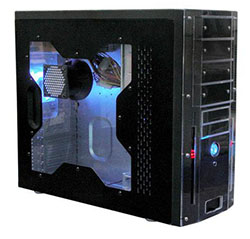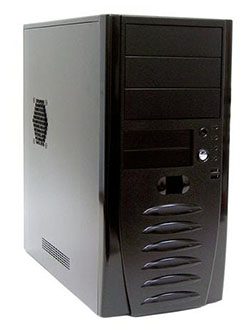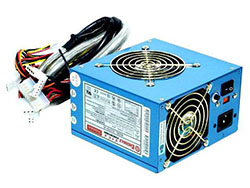Buyer's Guide - Entry Level to Mid-Range, March 2005
by Jarred Walton on March 15, 2005 1:30 PM EST- Posted in
- Guides
Case and Power Supply
Now that we have all the internal components picked out, it's time to find them a nice home. If you're not too choosy about the appearance of your computer, you can probably just head over to the local computer shop and pick up the cheapest case that you can find. Some may be more or less durable, but the vast majority of the steel cases on the market will manage to work just fine once everything is installed. You may cut a finger or scrape a knuckle if you're not careful with some of the cheap cases, but if you don't plan on upgrading often - or ever - such considerations don't matter a whole lot. Buy what you like, whether that's a boring case or something with 60s era sci-fi theme. More important than the case, however, will be the choice of power supply.Many of the sub-$50 cases that include a power supply could potentially have stability problems, so for peace of mind, we would strongly encourage you to pick up a better PSU for your system. You can always keep the original generic PSU around as a backup in case you have problems. If you're going to get a motherboard with PCI Express support, you will probably want to look at separate power supplies with the new 24-pin power adapter. As far as quality goes, Enermax and Antec continue to be the most recognized brands. They are also priced such that getting them into a budget system may be difficult unless you purchase a case with an included power supply. That would be our recommendation, with the Antec SLK1650 continuing to offer decent looks and performance for a reasonable price. But some people like to see what else is out there, so we've searched around to come up with some new options.
Case Recommendation: Rosewill ATX with 400W PSU, model TU-155
Price: $59 shipped
Rosewill is a newer brand on the market, but they've really manage to impress a lot of people looking for good values. Their cases have managed to catch our eye, and while we might question the reliability of the PSU, $61 for a case with a window as well as front USB and firewire ports is pretty impressive, and the PSU is pretty much gravy. You can find similarly priced offerings from Apex, Aspire, Codegen, In Win, Logisys and RAIDMAX, among others, but we like the overall look of the TU-155 as something different from the "boring" cases.
Case Alternative: Antec SLK1650B with 350W PSU
Price: $65 shipped
As we've so often pointed out, once you factor in the cost of shipping and a reasonable power supply, it's difficult to beat the Antec cases, particularly the low-end SLK16xx models. They are good, cheap cases with a reasonable quality PSU along with a single 120 mm temperature controlled rear fan. The one flaw is that the PSU is a standard ATX model, so adapters would be necessary if you want the full 24-pin power supplied to the motherboard. It is not strictly required to have a 24-pin power connector, of course, and when paired up with a relatively low-power PCIe card like the 6200TC, you should be fine. Down the road, however, it may become necessary to upgrade the PSU. With shipping adding almost $20 to the cost, however, it does hurt our overall budget. If you're willing to take the risk of a cheaper power supply, you can easily find cases at a local shop for under $50.
PSU Alternative: Enermax Noisetaker 370W, model EG375P-VE-SFMA
Price: $51 shipped
We've mentioned the quality of Enermax power supplies many times in the past. For this Guide, we felt it was important to make sure that the alternative PSU included a 24-pin power connector. [Unfortunately, we got bad information from Enermax's web site - this is not a 24-pin PSU! See note below.] While there are 20-to-24-pin adapters available, they are not guaranteed to work with upgraded video cards. 370W may seem on the low end of the scale, but remember that this is a quality 370 Watts, and it will certainly outperform most 400W to 450W competitors. The Noisetaker line is also one of the quieter power supply options out there, although it certainly isn't silent. For $50, though, you can't complain too much. As always, you can look at Antec, Fotron Source, PC Power and Cooling, Tagan, and ThermalTake as generally good quality options, if you want something other than the Enermax that we've suggested.
Updated Information: Have you ever had difficulty tracking down a reasonable choice for a component, based on a specific price range? If so, then you've probably built quite a few PCs, or perhaps written a guide such as this. Trust me, I searched for quite a while trying to find a reasonable 24-pin PSU for this Guide. I figured that if I'm going to recommend an alternate PSU, then it ought to have some longevity. Sure, $100+ Antec, Enermax, OCZ, etc. PSUs will provide you with everything you might need, as well as a 3 to 5 year warranty in many instances. However, $100 is a lot of money for a power supply, even in the mid-range sector.
The Enermax pages have images showing 24-pin compatibility on their web site for the above 370W PSU. While we still feel it's a very good PSU and it does include dual 12V rails, it does not have a 24-pin connector. The most reasonably priced PSU that we could find with a 24-pin connector is the A+ GPB/Athena Power 500W, model AP-P4ATX50F12. It costs around $60 shipped and appears to be a good quality PSU, but we're not sure about noise levels. Most other 24-pin PSUs cost substantially more, unfortunately. If you have any better suggestions for this price range, drop me a line. Thanks, and sorry for the confusion!













59 Comments
View All Comments
JarredWalton - Tuesday, March 15, 2005 - link
17 - The older Maxtor are like the older WD: they use standard bearings and are prone to develop a whine (in my experience). If you can verify that the drive has fluid dynamic bearings, you could get Maxtor as well. I haven't had great experiences with the Maxtor drives, although I've heard the latest models are better.JarredWalton - Tuesday, March 15, 2005 - link
15 - Sorry, I meant "9550" but typed "5500". The article lists the correct card, though. :o Most of the FX cards aren't worth consideration.As for the 6200TC, there are actually 3 versions, all of which were tested in the AnandTech article. There is a 16MB 16-bit card (one RAM chip), a 32MB 32-bit card (two RAM chips), and a 64MB 64-bit card (four RAM chips). The 32MB cards are not a 64-bit interface as far as I am aware. Many companies are causing confusion on the TC cards as they'll count the PCIe connection as bandwidth in order to make the features look better. Even if the RAM were 700 MHz instead of 550 MHz, you're looking at 2800 MBps on-card bandwidth for the 32-bit version vs. 4400 MBps on the 64-bit version. In theory, the PCIe connection will add an additional 2000 MBps (roughly - 2000 up and 2000 down) , but some of the RAM bandwidth is going to the CPU.
16 - I'd take the guaranteed 6600 for $7 more over the 6200. The 6200 also lacks support for certain memory compression schemes as I understand it.
Klober - Tuesday, March 15, 2005 - link
I know this is a minor point, but I'm curious as to why Maxtor isn't mentioned in the price guide for hard drives. Is there something I don't know about them concerning speed, noise or reliability?filterxg - Tuesday, March 15, 2005 - link
To most people I'd continue to recommend a 6200 over a 6600 vanilla. Rivatuner unlocks the 4 pipelines (softmod), so it becomes an indentical card.Jep4444 - Tuesday, March 15, 2005 - link
"Oh, as far as the budget PCIe card recommendation going to the 64MB 6200TC, please read the benchmarks in our 6200TC article before saying that the 32MB/32-bit version is better (due to memory speeds)."you seem to be confusing cards, i'm talking about the 32MB/64bit part thats clocked at 700mhz(as opposed to 550mhz of the 64MB one)
you're thinking of the 16MB version thats 32bit
PS who said to use the 5500? he mentioned the 9550 which is faster than the 5500
JarredWalton - Tuesday, March 15, 2005 - link
13 - Regarding refurb, that's something for the individual to decide. Warranty and availability are limited, so we don't recommend them in Guides. I still don't know about the Chaintech, as I can't find concrete information on specs for the Ultra vs. standard. According to Chaintech, it's the standard nF4 vs. the Ultra, which means the only thing that gets lost is SATA-2 support and a few network "enhancements". They're the same chipset with different resistors cut.Fricardo - Tuesday, March 15, 2005 - link
Same as those above, I'd say go with a 6600 non-gt for the upgraded setup. If you're actually going to upgrade the vid-card -- indicating you care somewhat about gaming -- you might as well do it right and spend the extra $7.Is it worth the $10 savings to go from the Ultra mobo to the vanilla? I don't know but I've heard that chipset wasn't made to OC well. Seems like you'd get a bit more value and $99 is still a great price for a mobo. I'm just wondering.
Another possibility for reducing cost is refurbed parts. I've been looking through NewEgg's refurb video section lately and there's tons of great cards for cheap. PCI-Express too. It seems to me you can really raise value that way.
JarredWalton - Tuesday, March 15, 2005 - link
Oh, as far as the budget PCIe card recommendation going to the 64MB 6200TC, please read the benchmarks in our 6200TC article before saying that the 32MB/32-bit version is better (due to memory speeds). The bump from 32-bit to 64-bit more than makes up for the slower RAM (if it is indeed slower). The 64MB 6200TC also beats the X300 in *every* test, so there's no reason to go with the X300 card unless you insist on ATI.http://www.anandtech.com/video/showdoc.aspx?i=2300...
I'm actually not fully convinced the "TurboCache" architecture really works all that well. Looking at the various cards, the performance scales almost directly with local memory bandwidth. But that's a topic for another day.
JarredWalton - Tuesday, March 15, 2005 - link
Oops... some bad picks on the GPUs this time. I keep forgetting the 5500. I have updated the GPU page with new picks, and will shortly update the summaries. I guess after seeing 6600 AGP prices I forgot that the PCIe cards were substantially less. Sorry.I also corrected the VNF4 to omit the Ultra. I can't tell if the Ultra includes Firewire support or not. Newegg, at least, is using the same images for both models. I think that's what threw me off in the first place.
rivethead - Tuesday, March 15, 2005 - link
Sorry about my post #7. I just re-read it and I wasn't very clear.What I was trying to say is that I think you're wanting to recommend the Chaintech VNF4 mother board (currently $89 shipped from newegg). This board is different than the Chaintech VNF4/Ultra which is about $100 shipped. For the extra $11, you get a motherboard powered by the nvidia nForce 4 Ultra chip which includes onboard firewall, SATA2 support, and nvidia nTune performance software.
For me, I think the extra $11 is worth the features.
I beleive you'll need to either change the price or alter the narrative to be clearer on your board selection.
But if you really can find the Chaintech VNF4/Ultra for $89 please let me know where!